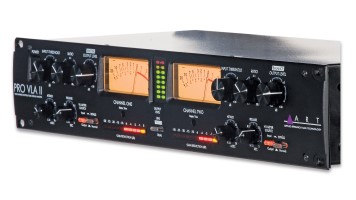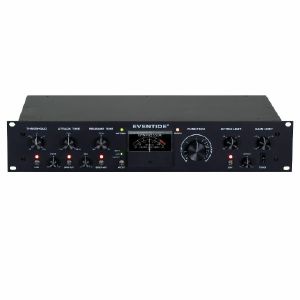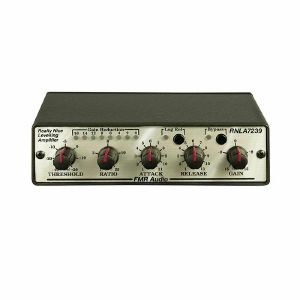Compressors Limiters & Gates
Essentials for studio recording and live sound setups, compressors, limiters and gates allow you to control the dynamics of your audio signals. Compressors and limiters effectively reduce the level of a signal once it passes a certain threshold, allowing you to smooth out the peaks. Gates are mainly used for cutting out noise, closing completely once the signal falls below a set level. Our range includes models from leading brands such as DBX Pro, Applied Research & Technology and FMR Audio, offering neutral processors for live setups and more coloured options for adding character in the studio.

Artículos del 1 al 3 de 3 en la página 1 de 1
Eventide Omnipressor 2830Au Dynamics Effects Processor (B-STOCK) (audio compressor)
Cat: 1072636 Rel: 01 Jan 90
B-STOCK: Box opened, product in perfect working order
Notes: ***B-STOCK: Box opened, product in perfect working order***
Compression, expansion, noise gates and limiting are the cornerstones of the 50th anniversary Model 2830*Au Omnipressor, a true powerhouse of dynamic processing from one of the most iconic names in the business.
Supplier's Notes:
In 1973, Eventide Clockworks introduced the Omnipressor, the first studio product to encourage the use of dynamics for special effects. It joined the Instant Phaserr in studios worldwide, with the Instant Flanger following shortly after. All were used on countless recordings and are now considered truly classic products. Unlike the Phaser and Flanger, the Omnipressor, with its still-unique dynamic reversal, infinite compression, variable gating and separate "side chain," was discontinued a few years later. It had become difficult to obtain some exclusive parts and even more difficult to explain it to an industry that was much less sophisticated than it is today.
Omnipressor was the first dynamics effects processor of any kind, suddenly making possible a new, wide range of dynamics effects unlike anything that had come before it. Originally invented by Eventide's founder, Richard Factor (and later redesigned for production by Jon Paul), the Omnipressor made a host of dynamic effects possible. It featured variable control of all aspects of dynamic modification. It also introduced the notion of the 'side chain' and foretold techniques that today we take for granted like 'look ahead' processing. One of Eventide's first customers was Brian May, the lead guitarist of Queen.
Eventide now announces the golden-anniversary Omnipressor Model 2830*Au. The original handdrawn schematics were in the Eventide archives, and the new model is a faithful replica designed with the same circuitry and the same sound as the original 2830.
The new *Au model features the ability to link multiple units and is fitted with input and output audio transformers, which were a costly option on the original. Other improvements include a universal power supply and a back-lit meter, as well as more convenient TRS/XLR connectors replace the original terminal strip.
Specifications
Analogue Audio I/O
XLR and 1/4" Line In
XLR and 1/4" Line Out
XLR and 1/4" Side Chain In
XLR and 1/4" Side Chain Out
1/4" Link In
1/4" Link Out
Physical
Size
Inches: 3.5h x 19w x 8.9d
Metric: 8.9h x 48.3w x 31.7d
Weight
14 pounds (6.4kg) net
What's in the box:
Omnipressor
US-type IEC power cord
Omnipressor poster
Omnipressor manual
Eventide sticker
Eventide guitar pick
… Read moreCompression, expansion, noise gates and limiting are the cornerstones of the 50th anniversary Model 2830*Au Omnipressor, a true powerhouse of dynamic processing from one of the most iconic names in the business.
Supplier's Notes:
In 1973, Eventide Clockworks introduced the Omnipressor, the first studio product to encourage the use of dynamics for special effects. It joined the Instant Phaserr in studios worldwide, with the Instant Flanger following shortly after. All were used on countless recordings and are now considered truly classic products. Unlike the Phaser and Flanger, the Omnipressor, with its still-unique dynamic reversal, infinite compression, variable gating and separate "side chain," was discontinued a few years later. It had become difficult to obtain some exclusive parts and even more difficult to explain it to an industry that was much less sophisticated than it is today.
Omnipressor was the first dynamics effects processor of any kind, suddenly making possible a new, wide range of dynamics effects unlike anything that had come before it. Originally invented by Eventide's founder, Richard Factor (and later redesigned for production by Jon Paul), the Omnipressor made a host of dynamic effects possible. It featured variable control of all aspects of dynamic modification. It also introduced the notion of the 'side chain' and foretold techniques that today we take for granted like 'look ahead' processing. One of Eventide's first customers was Brian May, the lead guitarist of Queen.
Eventide now announces the golden-anniversary Omnipressor Model 2830*Au. The original handdrawn schematics were in the Eventide archives, and the new model is a faithful replica designed with the same circuitry and the same sound as the original 2830.
The new *Au model features the ability to link multiple units and is fitted with input and output audio transformers, which were a costly option on the original. Other improvements include a universal power supply and a back-lit meter, as well as more convenient TRS/XLR connectors replace the original terminal strip.
Specifications
Analogue Audio I/O
XLR and 1/4" Line In
XLR and 1/4" Line Out
XLR and 1/4" Side Chain In
XLR and 1/4" Side Chain Out
1/4" Link In
1/4" Link Out
Physical
Size
Inches: 3.5h x 19w x 8.9d
Metric: 8.9h x 48.3w x 31.7d
Weight
14 pounds (6.4kg) net
What's in the box:
Omnipressor
US-type IEC power cord
Omnipressor poster
Omnipressor manual
Eventide sticker
Eventide guitar pick
1 in stock $1,731.04
FMR Audio RNLA7239 Really Nice Levelling Amplifier (stereo levelling amplifier)
Cat: 823968 Rel: 18 Oct 21
Compressor reminiscent of some classic opto compressors
Notes: What It Is
Years ago, many RNC users pined for less invisible compression and requested that FMR Audio offer a more "colourful" compressor, suitable for bass guitar, drums and other sources in need of added sonic texture. In response, the FMR designer went to the RNC archives and resurrected a version of RNC software that had been rejected for release because it wasn't invisible enough! The result: a compressor reminiscent of some classic opto compressors used to just "level" the signal rather than tame every transient. To celebrate the RNLA's sonic "colour", a bright red knob* was chosen as a visual metaphor. Although the most recent version ships with a less ostentatious red-striped knob (not shown), the RNLA's sonic colour remains bolder than ever...
How It Sounds
"Thick" and "gooey" is how some customers have described the RNLA's sound. The RNLA is, admittedly, much "gentler" and not as apt to grab'n'run with the signal. Like an old-timey photocell, the RNLA is a little resistant to responding right away, but requires the signal to be there for a while to get the photocell to act. This action yields a soft musicality to the compressor's action that adds a desirable characteristic to the source signal.
How It's Done
The RNLA and the RNC share much of the same hardware, but run different algorithms to achieve the desired effect. The RNLA exercises the well-known dictum (among dynamic processor designers) that, after the static characteristics of the signal path, the main contributors to a processor's sound are the shapes of the attack & release envelopes. The RNLA's software then transforms the sidechain signal into a drive signal for the VCA that both slows things down a bit and totally reshapes the crisp and quick action of the RNC's "normal" mode. This reshaping (and slow down) are the primary sonic drivers behind the RNLA's "thick and gooey" sound!
… Read moreYears ago, many RNC users pined for less invisible compression and requested that FMR Audio offer a more "colourful" compressor, suitable for bass guitar, drums and other sources in need of added sonic texture. In response, the FMR designer went to the RNC archives and resurrected a version of RNC software that had been rejected for release because it wasn't invisible enough! The result: a compressor reminiscent of some classic opto compressors used to just "level" the signal rather than tame every transient. To celebrate the RNLA's sonic "colour", a bright red knob* was chosen as a visual metaphor. Although the most recent version ships with a less ostentatious red-striped knob (not shown), the RNLA's sonic colour remains bolder than ever...
How It Sounds
"Thick" and "gooey" is how some customers have described the RNLA's sound. The RNLA is, admittedly, much "gentler" and not as apt to grab'n'run with the signal. Like an old-timey photocell, the RNLA is a little resistant to responding right away, but requires the signal to be there for a while to get the photocell to act. This action yields a soft musicality to the compressor's action that adds a desirable characteristic to the source signal.
How It's Done
The RNLA and the RNC share much of the same hardware, but run different algorithms to achieve the desired effect. The RNLA exercises the well-known dictum (among dynamic processor designers) that, after the static characteristics of the signal path, the main contributors to a processor's sound are the shapes of the attack & release envelopes. The RNLA's software then transforms the sidechain signal into a drive signal for the VCA that both slows things down a bit and totally reshapes the crisp and quick action of the RNC's "normal" mode. This reshaping (and slow down) are the primary sonic drivers behind the RNLA's "thick and gooey" sound!
2 in stock $278.98
Click for better price!
or call +44 20 7424 1960
quote 823968
quote 823968
FMR Audio RNC1773 Really Nice Compressor (stereo compressor)
Cat: 823964 Rel: 18 Oct 21
Compact and cost-effective stereo compressor with a high-fidelity audio path and compression scheme
Notes: A solid gold modern classic from FMR. The RNC must be one of the biggest studio bargains around. Proper analogue compression with digital control, offering pro sound at an affordable price.
Supplier's Notes:
What It Is
FMR Audio's first product, introduced over 18 years ago, the Really Nice Compressor (RNC) is a compact and cost-effective stereo compressor with a high-fidelity audio path and compression scheme. The RNC provides quality compression at a budget price.
How It Sounds
The RNC provides two modes of operation. One allows the RNC to be used for special effects, like snappy snares or popping basses. The other provides near-invisible signal compression for sensitive material where compression artifacts are less desirable (like natural vocals, acoustic guitar or the program bus). The RNC yields clean, airy compression with few artifacts and little high-end loss, even at massive gain reduction! The amazing performance is why- even after almost 20 years- many professionals are calling the RNC one of the best sounding compressors for under $2000.
How It's Done
The RNC achieves such high performance at a low cost by using using a microprocessor to replace discrete sidechain components (resistors, diodes, capacitors, opamps, transistors, etc) with chunks of software, thereby reducing the component cost. This approach, however, still processes the main audio in the analog domain, avoiding the problems associated with digital audio conversion (e.g., latency, digital artifacts). Even the problem of "scratchy" pots and switches are avoided: no audio flows through the front-panel controls. The front-panel pots and swtiches merely feed DC voltages to the microprocessor and it takes care of adjusting parameters and signal path with components - like sealed-relays and VCAs - located close to the input/output jacks avoiding noise pickup and audio quality reduction due to aging controls! With this blend of technology, the RNC offers the accuracy and precision of digital control with the clean tonal character of an all-analog signal path. The RNC's digital control permits accurate repeatability of your favorite settings.
… Read moreSupplier's Notes:
What It Is
FMR Audio's first product, introduced over 18 years ago, the Really Nice Compressor (RNC) is a compact and cost-effective stereo compressor with a high-fidelity audio path and compression scheme. The RNC provides quality compression at a budget price.
How It Sounds
The RNC provides two modes of operation. One allows the RNC to be used for special effects, like snappy snares or popping basses. The other provides near-invisible signal compression for sensitive material where compression artifacts are less desirable (like natural vocals, acoustic guitar or the program bus). The RNC yields clean, airy compression with few artifacts and little high-end loss, even at massive gain reduction! The amazing performance is why- even after almost 20 years- many professionals are calling the RNC one of the best sounding compressors for under $2000.
How It's Done
The RNC achieves such high performance at a low cost by using using a microprocessor to replace discrete sidechain components (resistors, diodes, capacitors, opamps, transistors, etc) with chunks of software, thereby reducing the component cost. This approach, however, still processes the main audio in the analog domain, avoiding the problems associated with digital audio conversion (e.g., latency, digital artifacts). Even the problem of "scratchy" pots and switches are avoided: no audio flows through the front-panel controls. The front-panel pots and swtiches merely feed DC voltages to the microprocessor and it takes care of adjusting parameters and signal path with components - like sealed-relays and VCAs - located close to the input/output jacks avoiding noise pickup and audio quality reduction due to aging controls! With this blend of technology, the RNC offers the accuracy and precision of digital control with the clean tonal character of an all-analog signal path. The RNC's digital control permits accurate repeatability of your favorite settings.
3 in stock $229.68
Click for better price!
or call +44 20 7424 1960
quote 823964
quote 823964
Artículos del 1 al 3 de 3 en la página 1 de 1

 USD
USD








